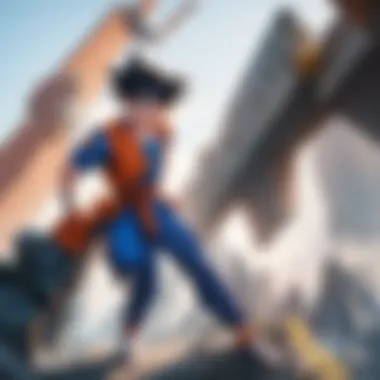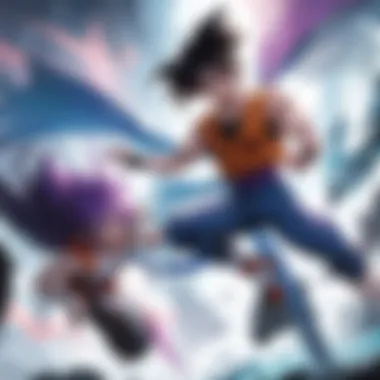The Complete Overview of Dragon Ball Series


Intro
The Dragon Ball franchise is an enduring icon in the world of anime and manga. Its inception began in the mid-1980s, with Akira Toriyama crafting a series that would redefine action storytelling across multiple generations. With its unique blend of action, humor, and adventure, Dragon Ball quickly captured the imagination of audiences worldwide.
As the franchise evolved, it expanded into various series, movies, and spin-offs, reflecting not only Toriyama's creativity but also the shifting dynamics of popular culture. This comprehensive guide will shed light on the intricacies of Dragon Ball, from the original Dragon Ball to Dragon Ball Super, along with character explorations and the significance of its themes.
Understanding the tensions and triumphs in the narrative, along with character growth, enriches the viewer's experience. Here, we will delve into episode summaries, character profiles, and vital differences between the anime and manga formats.
Additionally, we will explore industry news as it relates to this iconic franchise and provide insights into audience reception over the years.
This overview will appeal to both seasoned fans and newcomers eager to understand the vast reach of the Dragon Ball universe.
Intro to Dragon Ball
In the realm of anime and manga, few franchises hold as significant a place as Dragon Ball. This series has not only defined the shonen genre but has also influenced countless storytellers, artists, and fans around the world. Understanding the origins, development, and impact of Dragon Ball is essential for appreciating the nuances of its characters and themes. It offers insight into what makes the narrative resonate with such a broad audience.
Origins of the Franchise
Dragon Ball was created by Akira Toriyama, debuting as a manga in 1984 in Weekly Shōnen Jump. The inspiration for the series draws from the classic Chinese novel Journey to the West. Toriyama combined elements of adventure, martial arts, and sci-fi, leading to a unique formulation that captured readers’ attention. The central premise revolves around Goku, a young fighter on a quest for the Dragon Balls, mystical orbs that grant wishes when gathered.
The early success of the manga led to an anime adaptation in 1986. This adaptation helped popularize the franchise, expanding its reach beyond Japan. As the franchise grew, it established itself not just as a story, but as a cornerstone of popular culture.
Initial Release and Reception
Upon its premiere, Dragon Ball's initial reception was mixed. Critics appreciated its art style and comedic elements, but some were skeptical of its pace and plot depth. However, as the series developed, it quickly gained avid followers. Viewers became invested in the characters, the battles, and the broader universe that Akira Toriyama had created.
The whimsical nature of Dragon Ball set it apart from other series at the time. Elements such as the humor interspersed with action attracted an audience of varying age groups.
By the time Dragon Ball Z was released, the franchise had transformed from a manga into a cultural phenomenon. It expanded the scope with high-stakes battles and deeper character development. The series helped set standards in storytelling and animation that many later works would aspire to match.
The influence of Dragon Ball is evident in both the anime industry and in the hearts of fans across the globe. Its themes of perseverance, friendship, and adventure await anyone who embarks on this journey.
In summary, the introduction to Dragon Ball establishes both the series' rich legacy in its early days and its far-reaching impact on later generations of manga and anime.
The Structure of the Series
The structure of the Dragon Ball series is pivotal for understanding how this iconic franchise develops over time. Each segment contributes to a larger narrative, showing the evolution of its characters, themes, and even animation styles. The various parts of the series provide viewers with diverse storytelling techniques while keeping consistent core ideas that resonate throughout.
Dragon Ball


"Dragon Ball" is the foundation of the series. Released in 1986, it introduces Goku, a boy with extraordinary strength and a pure heart. His journey begins innocently as he searches for the Dragon Balls to summon the eternal dragon Shenron. Through martial arts tournaments and encounters with memorable allies and adversaries, this portion of the series sets the tone for adventure and exploration. It is essential as it lays the groundwork for themes of friendship, perseverance, and the importance of self-discovery.
Dragon Ball Z
"Dragon Ball Z" is a continuation that escalates the stakes considerably. Premiering in 1989, this segment introduces new characters like Vegeta and Frieza. The battles become more intense, paving the way for high-stakes conflicts. Dramatic moments, such as Goku's transformation into a Super Saiyan, are central highlights. This series serves not only as a sequel but as a critical phase where the depth of character development is explored. The audience witnesses Goku grow from a novice fighter to a defender of Earth, and the complexity of rivalries, particularly with Vegeta, changes the landscape of character dynamics significantly.
Dragon Ball GT
"Dragon Ball GT" diverges somewhat from the preceding elements. While it was not based on the original manga, it explored more unique storylines. Debuting in 1996, GT offers a fresh perspective, featuring Goku as a child and venturing into outer space. Though opinions on GT vary among fans, it serves to show the franchise's adaptability and willingness to experiment. It addresses themes of nostalgia and legacy, showcasing how even established heroes can encounter new challenges.
Dragon Ball Super
"Dragon Ball Super" returns to the narrative roots set by the earlier parts of the series while also expanding its universe. Launched in 2015, it introduces multiverse concepts, alongside new heroes and villains, augmenting the lore significantly. This segment reflects a maturity in storytelling, focusing on not just battles but the implications of power and responsibility. The show reignites discussions of legacy and heroism, especially through Goku's interactions with other powerful beings. It merges humor with action in a way that appeals to both long-time fans and newcomers.
In summary, the structure of the Dragon Ball series allows for a rich narrative experience. Each segment contributes to a cohesive yet evolving storyline. By exploring how these elements interact and change over time, one gains deeper insight into the enduring appeal of the franchise. Beyond the characters and plots, understanding the structural development elucidates why this series remains a cornerstone of anime culture.
"The evolution of the Dragon Ball series encapsulates the essence of growth in storytelling, merging both the familiar and the new."
For more insights into this series, you can visit Wikipedia's Dragon Ball page.
Notable Characters
The characters in the Dragon Ball series are central to its narrative and thematic development. These individuals are not just figures on the screen; they embody the series' messages of perseverance, growth, and friendship. Understanding their journeys enriches the viewer's experience and highlights the intricate storytelling woven throughout the franchise.
Goku
Goku is the protagonist and most recognizable figure in the franchise. He begins his journey as a naive child, unaware of his alien heritage. His character evolves throughout the series as he faces adversaries and seeks self-improvement. Goku's relentless pursuit of strength is not motivated solely by a desire for power; he seeks to protect his loved ones and challenge formidable foes. This duality makes him relatable and admirable. His ability to form connections with diverse characters, like his rivals and friends, underscores the importance of relationships in the series. Goku's transformations, such as Super Saiyan, symbolize his growth and the series' overall themes of overcoming limits.
Vegeta
Vegeta, initially introduced as an antagonist, becomes one of Goku's fiercest rivals and eventual allies. His journey from a prideful Saiyan Prince to a character driven by protectiveness and loyalty adds significant depth to the storyline. Vegeta's rivalry with Goku fosters character development for both. He represents the darker aspects of ambition and rivalry, contrasting Goku's often carefree nature. The complexity of his character, including his struggles with pride and redemption, engages viewers. Vegeta's transition to heroism showcases the franchise's exploration of change and personal growth.
Bulma
Bulma is not just a supporting character; she plays a vital role in the series' progression. As one of Goku's earliest friends, she is integral to many story arcs. Her intelligence and resourcefulness are showcased through her technological innovations, which often aid the Z fighters. Bulma's character challenges traditional gender roles in the narrative, proving that strength comes in many forms. Her relationships with other characters, particularly her dynamic with Vegeta, evolve significantly. This pairing demonstrates themes of family and partnership, adding layers to the storyline.
Piccolo
Initially introduced as a villain, Piccolo undergoes one of the most profound transformations in the series. His evolution from a ruthless enemy to a devoted mentor for Goku's son, Goten, exemplifies the series' themes of redemption and growth. Piccolo serves as a counterbalance to Goku's more naive nature, advocating for strategy and wisdom. His deep sense of duty and sacrifice adds a serious tone to the often lighthearted journey of the series. Piccolo's fusion with Namekian warriors enhances the narrative by showcasing themes of unity and collaboration.


Frieza
Frieza is often considered one of the most iconic villains in Dragon Ball history. His cold demeanor and ruthless tactics set the stage for numerous conflicts. Frieza's character explores themes of tyranny and the nature of evil. His battles with Goku and Vegeta underscore the narrative tensions between good and evil. However, Frieza's character also highlights the cyclical nature of conflict; even in defeat, he finds ways to return. The complexity of Frieza offers an engaging antagonist that drives the plot forward and adds gravity to the heroes' struggles.
"The characters in Dragon Ball exemplify the series' core messages of perseverance and growth, demonstrating that even the fiercest foes can evolve into allies."
The significance of these characters goes beyond their roles in battles. They represent ideals and struggles that resonate with audiences. Each character illustrates essential life lessons, enriching the overall experience of the Dragon Ball series. Their interactions and developments shape the narrative, making the franchise a compelling study of human (and alien) experiences.
Thematic Elements
In any long-running series, thematic elements serve as the backbone that connects its narrative to audiences. In the case of Dragon Ball, these themes resonate deeply. They encapsulate the journey, struggles, and growth of the characters, while also reflecting broader human experiences. The significance of these thematic elements enhances the depth of the series, inviting viewers to relate personally to the story.
Friendship and Rivalry
Friendship plays a vital role throughout the Dragon Ball series. The bonds formed between characters often propel the storyline and foster emotional investment in their journeys. For instance, the relationship between Goku and Vegeta showcases how rivalry can coexist with friendship, pushing both characters to become better versions of themselves. This duality is essential. It illustrates that competition can be constructive. When Goku and Vegeta spar, they not only aim to defeat one another but also to grow stronger. This theme of healthy rivalry extends to other characters as well, highlighting the importance of support and encouragement among friends.
Growth and Self-Improvement
The entire narrative arch of Dragon Ball revolves around growth and self-improvement. Goku exemplifies this theme, as he continually seeks out challenges to surpass his limits. The rigorous training methods, such as the use of the Hyperbolic Time Chamber, signify more than just physical strength; they reflect the internal journey of self-discovery. Characters like Piccolo demonstrate that personal growth is achievable even after egregious mistakes. By focusing on pushing boundaries, the series communicates the idea that anyone can evolve. Furthermore, it is not solely about power levels but also about emotional maturity and moral growth. This makes the theme universally relatable.
Redemption Themes
Redemption is intricately woven into the storyline of Dragon Ball. Characters like Frieza and Vegeta undergo significant transformations, signifying that it is never too late to change. These arcs emphasize that past actions do not have to define one's future. For instance, Vegeta starts as a ruthless antagonist but eventually becomes a key player in the fight against evil. This reformation underscores an essential message: everyone has the potential to change for the better. Through intricate storytelling, the series portrays redemption as a complex journey rather than a simple resolution, encouraging viewers to understand and empathize with characters on their paths to improve.
The themes of friendship, growth, and redemption within Dragon Ball not only drive character arcs but also resonate with audiences, illustrating the complexities of life and personal journey.
Cultural Impact
The Cultural Impact of the Dragon Ball franchise is essential to understanding its role in the anime landscape. This section examines how it has transcended entertainment to become a significant cultural phenomenon. Like few others, Dragon Ball has influenced not only its own genre but also broader aspects of popular culture worldwide.
Global Popularity of Dragon Ball
Dragon Ball has enjoyed a remarkable journey of popularity since its creation. Initially released in the 1980s, it quickly garnered a loyal fanbase. The series' unique blend of martial arts, adventure, and humor resonated with a diverse audience. This broad appeal is reflected in the franchise's ability to maintain relevance over decades.
Fans often note the impact of characters like Goku and Vegeta, which have given rise to an engaged community. The reach of Dragon Ball extends beyond Japan, with numerous localized versions airing internationally. Data from various surveys indicate that a significant percentage of anime viewers initially became interested in the medium through Dragon Ball. The series' popularity is further evident in its continuous airing on television and in streaming services, which keeps it accessible to new fans.
Dragon Ball in Video Games
The Dragon Ball franchise has expanded into video games, becoming a lucrative segment in its own right. Notable titles include Dragon Ball Z: Budokai and Dragon Ball FighterZ. These games have not only captured the essence of the anime but also introduced complex gameplay mechanics that appeal to both casual and hardcore gamers.


The success of Dragon Ball video games is a testament to its lasting popularity. Players can experience the series' iconic battles and story arcs interactively. The enduring success of these games has encouraged developers to explore new technologies and graphics, allowing for richer gaming experiences.
Merchandising and Commercial Success
Merchandising has played a crucial role in the commercial success of Dragon Ball. Products ranging from action figures to clothing items are now readily available. Brands capitalize on the franchise’s popularity, solidifying its status as a cultural icon.
The sheer volume of merchandise generated by Dragon Ball has also fostered community engagement. Collectors often share their collections on various platforms, including Reddit and Facebook. This interaction has contributed to an ongoing dialogue about the series and its impact.
In summary, the cultural impact of Dragon Ball is multifaceted. Its global popularity, expansion into video games, and significant merchandising efforts have created a legacy that continues to thrive. This enduring influence demonstrates why Dragon Ball remains a pivotal component of anime culture.
Artistic Style and Animation
The artistic style and animation in the Dragon Ball series play a pivotal role in shaping its identity and appeal. The visual elements contribute significantly to the storytelling and character development. The unique character designs, vibrant colors, and dynamic action sequences are not only visually striking but also enhance the viewer's engagement. With its blend of traditional and modern techniques, Dragon Ball stands out in the anime genre.
Character Design Evolution
The character design in Dragon Ball has evolved remarkably since its inception. Originally, Akira Toriyama's designs were influenced by various genres, including martial arts and science fiction. Characters like Goku and Bulma showcased simplicity with distinctive features, such as Goku's spiky hair and Bulma's hairstyles.
As the series progressed, character designs became more detailed. For instance, Vegeta's armor evolved to reflect his growing power and status. Similarly, the introduction of new characters in Dragon Ball Z brought different design aesthetics, showcasing a range from the wild Saiyan hairstyles to the sleek designs of the Androids. This evolution presented characters that were not only visually diverse but also aligned with their narratives, enhancing the connection fans felt towards them.
Animation Techniques
Dragon Ball's animation techniques varied throughout its timeline, adapting to technological advancements and audience expectations. The early episodes utilized hand-drawn animations, which had a certain charm yet came with limitations regarding frame rates. As the series moved into Dragon Ball Z, the use of more elaborate battle sequences became evident. Animators employed techniques like limited animation to emphasize intense fight scenes while maintaining fluid motion.
One significant technique that gained prominence was the use of dynamic camera angles during fights. This approach created a sense of depth, making battles more visually stimulating. Furthermore, newer iterations like Dragon Ball Super incorporated advanced CGI elements to blend with traditional animation, offering a fresh perspective without compromising the series' essence.
"Artistic choices in animation shape not only how a viewer perceives the characters but also enrich their understanding of the story's themes and emotional depth."
The transition from hand-drawn techniques to a mix of CGI and hand-drawn styles reflects the industry's growth while honoring the series' roots. Overall, the artistic style and animation of Dragon Ball significantly contributed to its enduring popularity and influence, resonating with audiences across generations.
End and Future
The conclusion and future of the Dragon Ball franchise is a significant topic that encapsulates the journey and the ongoing evolution of this iconic series. After examining the various elements that make Dragon Ball a staple in anime and manga culture, it is essential to understand where it stands today and what lies ahead. This segment also synthesizes key insights from previous sections, providing a comprehensive overview of its relevance in the modern context.
Current Status of the Franchise
Currently, Dragon Ball remains a highly influential series within the anime and manga landscapes. Dragon Ball Super, which reboots the narrative, has revitalized interest among both new audiences and long-time fans. Broadcasts of episodes still draw significant viewership, while manga sales continue to soar, confirming the franchise's enduring popularity.
In addition, the series has a robust presence in video games, with titles such as Dragon Ball FighterZ and Dragon Ball Z: Kakarot pushing the boundaries of interactive experiences. Moreover, the franchise continues to expand its merchandising ventures, leveraging recognizable characters and iconic scenes to maintain a strong commercial foothold.
"The Dragon Ball franchise has successfully adapted to changing trends in anime, ensuring that it remains relevant across generations.”
Future Prospects
Looking ahead, the prospects for the Dragon Ball franchise show a dynamic potential for growth and expansion. With ongoing developments in anime production and a dedicated fanbase, new stories are likely to emerge. There are speculations about further expansions within Dragon Ball Super, including possible new arcs that delve deeper into character backgrounds and unexplored narratives.
Furthermore, there could be opportunities for collaborative projects and crossover events with other franchises, aiming to boost engagement and intrigue within the anime community. As the landscape of anime continues to evolve, the adaptations in technology and storytelling may lead to innovative ways of consuming Dragon Ball content, potentially including virtual reality experiences or interactive streaming formats.





